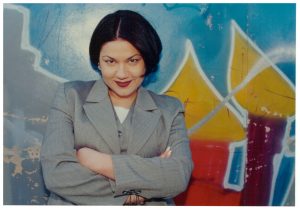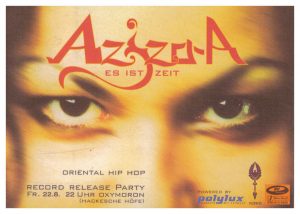Aziza-A. 1996. Foto: Orient Express.
erster weiblicher Star des Deutsch/Türkischen Hip-Hop in Deutschland in den 90igern. Ihre erste Veröffentlichung, die CD „Es ist Zeit“ (der gleichnamige Titelsong erschien vorab auf der Radio Multikulti CD „Breaking Walls“ ) war 1997 (LC1826, Orient Express/ArisBMG) first female star of German/Turkish Hip-Hop in Germany in the 90s. Her first release, the CD „Es ist Zeit“ (the title song of the same name appeared first on the Radio Multikulti CD „Breaking Walls“) was 1997 (LC1826, Orient Express/ArisBMG).
„Orient Express“ (Wolfgang Galler, Ulrich Sackenreuter, Andreas Spieß, Ünal Yüksel) unterstützte Aziza-A. beim Songwriting/Produktion, artist development, Bandaufbau, Management/PR, Booking, Rechtsberatung und Publishing. „Orient Express“ (Wolfgang Galler, Ulrich Sackenreuter, Andreas Spieß, Ünal Yüksel) supported Aziza-A. in songwriting/production, artist development, band structure, management/PR, booking, legal advice and publishing.
Die limitierte Einladungspostkarte zur Record Release Party am 22.8.1997 im Oxymoron (Hackesche Höfe) in Berlin fand u.a. ihren Weg in eine Publikation des Deutschen Historischen Museums in Berlin: The limited invitation postcard to the Record Release Party on 22.8.1997 at Oxymoron (Hackesche Höfe) in Berlin found its way into a publication of the German Historical Museum in Berlin:
Nadja Geer schreibt dazu: „(…) Inklusion und Exklusion können nahezu beispielshaft am Spiel mit Sprache und Symbolen nachvollzogen werden. Die Frage nach Distinktion oder Integration – vielleicht d i e Frage im Kontext von Popmusik und Jugendkultur – kann hier gestellt werden. Nicht nur in Deutschland, sondern weltweit.“Nadja Geer writes about this: „(…) Inclusion and exclusion can be almost exemplified by playing with language and symbols. The question of distinction or integration – perhaps t h e question in the context of pop music and youth culture – can be raised here. Not only in Germany, but worldwide.“
Aus: Katalog zur Ausstellung „Fremde?“, Bilder von den „Anderen“ in Deutschland un Frankreich seit 1871; herausgegeben von Rosmarie Beier-de Haan und Jan Werquet im Auftrag der Stiftung Historisches Museum, Berlin, Sandstein Verlag, Dresden, 2009 From: catalogue for the exhibition „Fremde?“, pictures of the „others“ in Germany and France since 1871; edited by Rosmarie Beier-de Haan and Jan Werquet on behalf of the Stiftung Historisches Museum, Berlin, Sandstein Verlag, Dresden, 2009
Aziza-A. trat in den späten 90igern und in den frühen 0er-Jahren u.a. in Roskilde (Dänemark), Lima (Peru) und in Ramallah (palistinensische Autonomiegebiete) auf und war als TV- (ZDF) und Radiomoderatorin (SFB, WDR) tätig. Auftritte in Talkshows und öffentlichen Diskussionsrunden. Hip-Hop Workshops für deutsch/türkische Mädchen. Schauspielrollen in Theaterstücken und Spielfilmen. Aziza-A. appeared in the late 90s and early 0s in Roskilde (Denmark), Lima (Peru) and Ramallah (Palestinian autonomous regions), among others, and worked as a TV (ZDF) and radio presenter (SFB, WDR). Performances in talk shows and public discussions. Hip-hop workshops for German/Turkish girls. Acting roles in plays and feature films.
Filmkompositionen u.a. Film compositions including
„HIZ“ (Alev Yildirim, Wolfgang Galler) für den 1999 Berlinale Spielfilm „Lola + Bilidikid“ von Kutlug Ataman (Zero Film/WDR/arte/CO Prod.) „HIZ“ (Alev Yildirim, Wolfgang Galler) for the 1999 Berlinale feature film „Lola + Bilidikid“ by Kutlug Ataman (Zero Film/WDR/arte/CO Prod.).
„OFSAYT“ (Alev Yildirim, Enis Rotthoff) für Evetl – ich will! von Sinan Akkuş (2008, evetichwill-derfilm.de) „OFSAYT“ (Alev Yildirim, Enis Rotthoff) for Evet – ich will! by Sinan Akkuş (2008, evetichwill-derfilm.de)
https://www.aziza-a.de/

